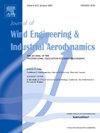Effects of turbulence on vortex-excited coupled vehicle-bridge systems: Wind tunnel investigation
IF 4.9
2区 工程技术
Q1 ENGINEERING, CIVIL
Journal of Wind Engineering and Industrial Aerodynamics
Pub Date : 2025-02-03
DOI:10.1016/j.jweia.2025.106020
引用次数: 0
Abstract
An accurate assessment of driving comfort and safety of road vehicles on a long-span bridge subjected to vortex-induced vibration (VIV) is crucial for bridge managers to decide whether the bridge should be closed to traffic or not. However, the previous studies often overlook the effects of turbulence on coupled vehicle and bridge systems subjected to VIV although turbulence does exist on site. In this study, vortex-excited coupled truck-bridge deck models were tested in a big wind tunnel under smooth and turbulence flows. Vortex-induced response (VIR) and vortex-induced force (VIF) of the bridge deck and the aerodynamic forces on the truck were measured simultaneously. The effects of the turbulence on VIR and VIF of the bridge deck with the truck(s) placed on different lanes were explored. The effects of turbulence on the mean and peak aerodynamic forces as well as acceleration response of the truck on the vortex-excited bridge deck were also investigated. The results show that VIR and VIF of the bridge deck are significantly influenced by turbulence intensities and truck locations. The mean and peak aerodynamic forces as well as acceleration response of the truck also vary significantly with turbulence intensities and truck locations.
湍流对涡激车桥耦合系统的影响:风洞研究
准确评估大跨度桥梁上道路车辆在涡激振动作用下的行驶舒适性和安全性,对于桥梁管理者决定是否关闭桥梁至关重要。然而,以往的研究往往忽略了湍流对车辆和桥梁耦合系统的影响,尽管湍流在现场确实存在。本文在大型风洞中对涡激耦合车桥桥面模型进行了平滑流场和湍流流场试验。同时测量了桥面板的涡激响应(VIR)、涡激力(VIF)和卡车的气动力。研究了在不同车道上行驶的货车,湍流对桥面横向振动系数和横向振动系数的影响。研究了湍流对卡车在涡激桥面上的平均气动力、峰值气动力和加速度响应的影响。结果表明,湍流强度和车辆位置对桥面的VIR和VIF有显著影响。卡车的平均和峰值气动力以及加速度响应也随着湍流强度和卡车位置的不同而显著变化。
本文章由计算机程序翻译,如有差异,请以英文原文为准。
求助全文
约1分钟内获得全文
求助全文
来源期刊
CiteScore
8.90
自引率
22.90%
发文量
306
审稿时长
4.4 months
期刊介绍:
The objective of the journal is to provide a means for the publication and interchange of information, on an international basis, on all those aspects of wind engineering that are included in the activities of the International Association for Wind Engineering http://www.iawe.org/. These are: social and economic impact of wind effects; wind characteristics and structure, local wind environments, wind loads and structural response, diffusion, pollutant dispersion and matter transport, wind effects on building heat loss and ventilation, wind effects on transport systems, aerodynamic aspects of wind energy generation, and codification of wind effects.
Papers on these subjects describing full-scale measurements, wind-tunnel simulation studies, computational or theoretical methods are published, as well as papers dealing with the development of techniques and apparatus for wind engineering experiments.

 求助内容:
求助内容: 应助结果提醒方式:
应助结果提醒方式:


